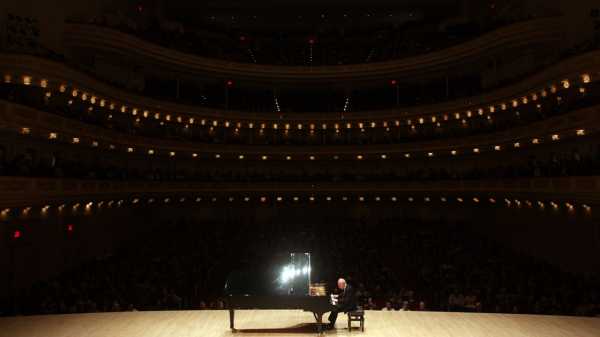
Though I often think about movies in relation to music, there’s also an aspect of music that’s similar to movies: drama. That aspect was in the forefront of an extraordinary piano recital by the Italian pianist Maurizio Pollini at Carnegie Hall on Sunday afternoon, not least because his performance told a varied and unusual range of stories. Pollini’s New York recitals turn the hall into a virtual high temple of pianism, because he’s possessed of an astoundingly precise and rapid technique to go with a profoundly intellectual insight into music. A classical-music performance is good to the extent that it illuminates the composition that’s being performed and the world of the composer who wrote it, and it’s for such revelations—for the musical drama of his relationships with pieces of music, with the psychology and the history of their creators—that it’s worth seeing Pollini. Another reason is that many of his studio recordings have a rigidity to go with their precision, whereas, in concert, Pollini (who is seventy-six) plays and thinks dangerously, as he did on Sunday.
The first half of the concert was devoted to Frédéric Chopin, and it was a surprise. Pollini’s Carnegie Hall recital last year was an all-Chopin program, and there (as in the set of Chopin pieces he played here in 2014) his performances were crystalline, marked by a pointillistic bravura that made every note of Chopin’s often wildly profuse compositions shine forth independently. On Sunday, his approach to Chopin was radically different: he used his pedals more heavily to blur series of notes and, instead of making the dots on the page glitter, he emphasized the way that they’re grouped and divided—he played not sprays and constellations of notes but sharply contrasted, disjoined phrases.
The story that Pollini told, with his newfound style, is a story of history—of contrasting versions of modernity. Playing two short pieces, the Prelude in C-Sharp Minor, Op. 45, and the Barcarolle, Op. 60, Pollini often broke melodies into abruptly short outbursts of notes and slightly desynchronized his hands to provoke sudden dissonances. Instead of melodic flow and harmonic structure, Pollini emphasized the dramatic ebb and flow of tempo, volume, and density—and this emphasis on gesture brought to mind a special kind of cinematic modernity, in which narrative continuities are both disrupted and intensified by images and editing that emphasize the disjunctive physicality of hands-on filmmaking.
In Pollini’s performance of the mighty Sonata No. 2 in B-Flat Minor, Op. 35—famous for its funeral march—he put his shoulders into it, making mighty thunder unlike any I’ve heard from him, and fragmenting and shifting phrases and melodies to make Chopin sound not improvisational and free but radically abrupt and fragmentary, to make the funeral march sound like a rage against the dying of the light. There’s another aspect, however, to Pollini’s hands-on camerawork with Chopin: his technique, among the glories of classical music, is a bit less secure than it used to be. In a small number of passages requiring both strength and speed, he fluffed a note or two—it doesn’t matter at all, since the goal of music isn’t perfection but expression, though I’d bet that it matters to Pollini, and that he recognizes that the rapid-fire multi-level precision that marked his playing of even a year ago is now sometimes a stretch. In the light of his new, albeit minor, fallibility, the rage against time takes on a sudden new pathos.
In the second half of the program, Pollini played the second book of Claude Debussy’s “Préludes,” from 1913, and here, too, his playing packed sonic, historical, and dramatic surprises. The dozen short pieces are actually preludes to nothing—unless it’s to the mini-dramas suggested by each piece’s title, such as “General Lavine—Eccentric” or “Fireworks.” But those titles and the characters or images that they suggest—in Pollini’s eruptive and analytical performance, forget them. Here, too, Pollini emphasized Debussy’s expressionistic discontinuities, suggesting the composer’s similarities to a contemporary: Arnold Schoenberg. Luxuriating in Debussy’s chromatic subtleties, Pollini made even the near-silence of the hall seem distractingly loud—until he shattered the stillness with percussive phrases of a fury reminiscent of another of the composer’s contemporaries, Béla Bartók. In short, Pollini stripped the music of its theatrical characterizations and visual impressions in order to lay bare its stark and fervent abstractions. By evaporating the humor, the whimsy, the theatrics, the implicit narrative, Pollini told another story, about a moment, a century ago, when, across a varied range of inspirations and experiences, classical music underwent a revolution that’s still being fought and disputed. The story that he told is a historical drama as stirring—and one as intimately psychological and poignant—as any onscreen.
Sourse: newyorker.com






